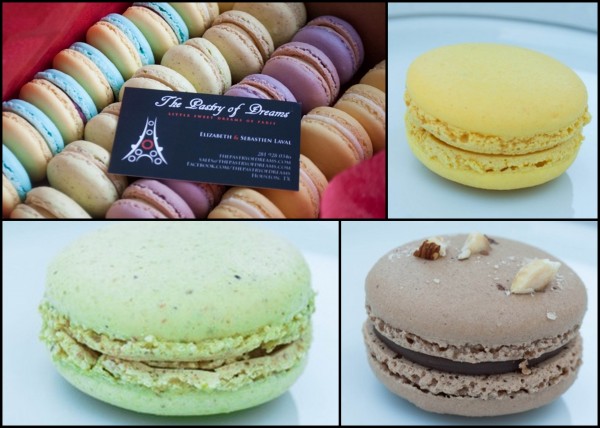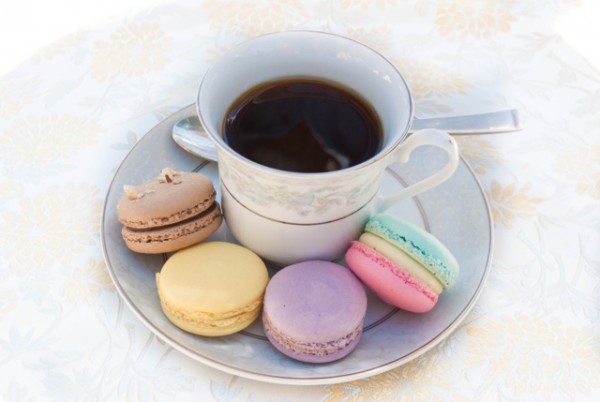I googled, but found only “10 signs of a bad macaron“. My pâtissière friend Hanna Lim told me a few criteria: a good macaron should look smooth on the surface, crunchy (but not crumbly) on the outside and a little chewy(*) inside, it should not fall apart when you take a bite, it should be a clean bite – no crumbs, no cream spewing out on the side. Looking through the Facebook page of The Pastry of Dreams, I see gliding smooth macarons and beautiful cookie-to-cream ratio. Visually, they are perfect.
But what impresses me most is their taste. These almond cookies reflect what real fruits and nuts taste like in a cookie. Instead of being masked by sugar, the flavors that each cookie is supposed to contain shine through. “There are no shortcuts in our pastries,” says Liz Laval, the chemist-turn-pastry-chef who started The Pastry of Dreams. For something as simple as vanilla, she uses special vanilla beans imported from Madagascar to France and shipped to her by family living in France. “The one from here and the one that people import here is useless, you have to use 2 vanilla beans to get the amount that one of mine would produce,” she explained as I took a bite.
It’s true. Her vanilla butter cream has the richest and sweetest aroma of any vanilla-flavored things I’ve ever eaten, and there was the nuttiness of vanilla beans that the extract simply cannot have. It was more vanilla-y.
The same principle applies for other flavors too, lemon zest and juice for lemon macarons, real lavenders in the cream and cookie shell of lavender macarons… Except for the chocolate macarons, Liz goes as far as avoiding using ganache as a shortcut to stabilize the cream, relying instead on a technique she learned from France which she asked me not to reveal. Of course, I have no intention of making macaron myself either. After tasting Liz’s macarons and learning about her 3 years of studying, including macaron classes at Le Notre and l’Ecole de Cuisine Alain Ducasse in Paris, and her 6 months experimenting in the kitchen, I figure it’s best to simply enjoy the work of the professional.

After all, it would be difficult to match her skill, which is repeatedly recognized by chefs and consumers alike. One of Liz’s favorite stories is the macaron match against the pastry chef at Hôtel Cloitre Saint Louis à Avignon, which she won. Another was the Saint Honoré, a puff pastry with rose chantilly, lychee cream and raspberry compote, which was made specifically for the Valentine’s Day menu at La Colombe d’Or, Houston this year, and it was the most ordered dessert that day. As I’m writing this post, she just got home from Le Grand Concours Macaron, a macaron contest hosted by the Texan-French Alliance for the Arts, bringing with her two awards. Her white-and-dark-chocolate Phantom of the Opera macaron won 2nd place for People’s Choice and Best Macaron by the judges.
During our dinner at her apartment in Houston, we talked about how desserts can be so overwhelming with sweetness that you can’t take more than a few bites. The dainty size of the macaron and its light texture, if done right, help alleviating the problem. “Making a macaron is about making art, you want it to be the last thing the person remembers from their entire meal. At the end of the meal, I want you to have the feeling of wanting more.” That’s her motivation. But as I watch her lively two-year-old son Liam playing with his lego crocodile and listen to her husband Sébastien telling stories of the crazy hurdles that are American immigration, I suddenly realize what it is that makes her pastry taste so good. The happiness of her family. A beautiful son, a supportive husband, a dedicated young lady – it’s a little family that makes onlookers want to have family or are reminded of their own familial love, the picture-perfect family. Liz is a happy chef. Intentionally or not, she lets that happiness seep into her pastries. We eat them, and get infected with a smile.
——————
The Pastry of Dreams is based in Houston, Texas.
Photo courtesy of Elizabeth Laval
——————
(*) In macaron language, as Liz told me, “chewy” is like tootsie roll chewy, which is of course not what I mean here at all. Because macaron are meringue-based sweets, macaron chefs want the macarons to be melt-in-your-mouth. As you bite into the macaron though, “melt in your mouth” is not how I would describe the sensation, in fact, you go from something dry to something moist, and that moistness is what I call chewy. 😉




Leave a Reply